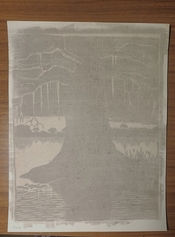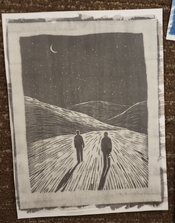kaelynlayne
Member
I was playing around with cuprotype/cyanotype/vdb chemicals, and did a funky mix.
10g water, 4g ferric ammonium citrate, 1g citric acid, 0.4g thio, and 5g 5% silver nitrate solution.
The printed out image pre-washing is nearly invisible. But then I did a coat with a 10% copper II sulfate solution (just brushed on), and got a deep rich brown. What is the source of the brown? I would have assumed the thio would have reacted with the silver nitrate in solution, and wasn't really expecting to get an image.
Dry print:

Still wet, with longer exposure time and a very high-contrast image of my own (not a photo, a drawing):

10g water, 4g ferric ammonium citrate, 1g citric acid, 0.4g thio, and 5g 5% silver nitrate solution.
The printed out image pre-washing is nearly invisible. But then I did a coat with a 10% copper II sulfate solution (just brushed on), and got a deep rich brown. What is the source of the brown? I would have assumed the thio would have reacted with the silver nitrate in solution, and wasn't really expecting to get an image.
Dry print:
Still wet, with longer exposure time and a very high-contrast image of my own (not a photo, a drawing):













